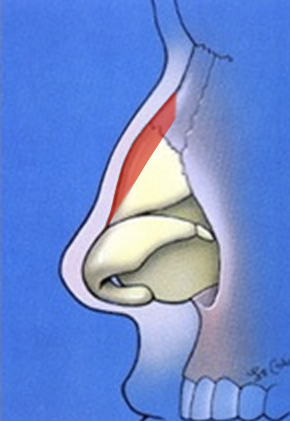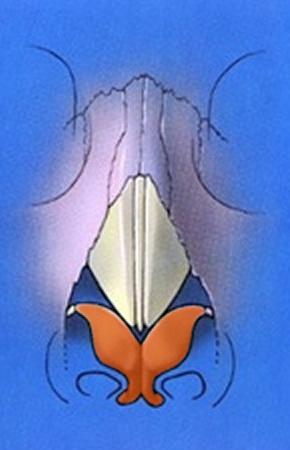Preservation rhinoplasty is one of the latest and most significant trends in the world of cosmetic nose surgery. So what is preservation rhinoplasty? Preservation rhinoplasty is a specific approach to reshaping the nose that involves preserving as much (if not all) of the native framework (cartilage and bone) in the process of accomplishing the aesthetic goals. In other words, preservation rhinoplasty does not involve traditional removal or resection of cartilage and bone that is so often done during routine rhinoplasty surgery.
Preservation of the Bridge
 To a great degree, preservation rhinoplasty refers to management of the nasal bridge and, more specifically, to treatment of a nasal hump deformity. A nasal hump deformity is also just known as a bump on the bridge. This is a very common cosmetic nasal concern that prompts many a patient to seek out rhinoplasty surgery.
To a great degree, preservation rhinoplasty refers to management of the nasal bridge and, more specifically, to treatment of a nasal hump deformity. A nasal hump deformity is also just known as a bump on the bridge. This is a very common cosmetic nasal concern that prompts many a patient to seek out rhinoplasty surgery.
Traditionally when a patient has a large bump on their nose, rhinoplasty surgeons will address this by rasping, or sanding, down the bone and cutting the excess cartilage off the bridge. This is shown conceptually in the adjacent diagram where you can see in red the section of the nose that is resected, or cut down by the rhinoplasty surgeon. This classically involves use of a surgical rasp to sand down the bone followed by cutting of the cartilage (the white shaded area in the diagram) to bring the bridge height down. By sanding down the bony hump and resecting the cartilage, the surgeon is able to achieve a straighter side profile view of the nose.
Unfortunately, when this particular surgical technique is used to take down a nasal hump deformity, there is a significant amount of disruption to the native framework of the nose. This type of disruption can really destabilize the structure of the nose. This only makes sense since we are literally resecting, or removing, a good portion of the bone and cartilage in an attempt to reduce the size of the nose. Once the bone and cartilage are removed, the surgeon has to do something during surgery in order to restore adequate, proper support of the remaining bridge. In fact, taking a hump down using this technique triggers a whole sequence of necessary steps that need to be taken in order to make the nose stable in the long run. And each step introduces more and more variables that can lead to potential abnormal healing. In turn, each of these increases the chances of postoperative cosmetic irregularities with the nose. Do all patients develop cosmetic problems after hump reduction rhinoplasty surgery? Well, no. But a decent percentage do, which can sometimes lead to the need to do touch ups to the nose after it has healed from rhinoplasty.
So what if we could effectively avoid having to deal with these issues altogether by preserving the nasal bone and cartilage – while still being able to lower the height of the nasal bridge? Well, we can! That is precisely what preservation rhinoplasty allows Dr. Hilinski to do – preserve the natural bone and cartilage in the process of lowering the nasal bridge height. This can be done using highly specialized surgical technique that involves making incisions deep within the nose rather than cutting the tissue overlying the bridge. By carefully and strategically removing certain segments of cartilage and bone inside of the nose, room is created so that the nasal bridge can drop down or be pushed down to the desired new location – thus lowering the bridge and getting rid of the hump deformity. By preserving the overlying bone and cartilage, the natural contour of the nasal bridge is maintained and less variables are introduced into the healing process. With less variables involved, there is less risk of patients having contour irregularities as the nose heals. In fact, the nasal bridge looks so much smoother and natural following preservation rhinoplasty surgery.
Preservation of Nasal Soft Tissue
Preservation rhinoplasty also implies that the surgeon is saving most of, if not all, the nasal soft tissue. More specifically, this involves preservation of what are called the soft tissue envelope and nasal ligaments . The soft tissue envelope essentially refers to the skin and subcutaneous tissue that cover the framework of the nose. The nasal ligaments are dense, fibrous bands inside of the nose (like rubber bands) that keep various types of tissue attached to one another – including the soft tissue envelope to the deeper cartilage. In classic rhinoplasty surgery, there is little regard paid to preserving the true layers of the soft tissue envelope and nasal ligaments. If these important structures are damaged or destroyed during rhinoplasty surgery, it can lead to unwanted consequences in terms of the shape of the nose – which, in turn, can ultimately result in the need for a revision rhinoplasty surgery. If one makes the extra effort involved with preserving the soft tissue envelope and nasal ligaments, there is usually a much more predictable outcome with less risk of postoperative complications.
Preservation of the Alar Cartilages
 The other significant aspect of preservation rhinoplasty involves saving the alar cartilages as much as possible. The alar cartilages are in reference to the cartilage segments that comprise the nasal tip, as is shown in the adjacent diagram in the shaded orange color.
The other significant aspect of preservation rhinoplasty involves saving the alar cartilages as much as possible. The alar cartilages are in reference to the cartilage segments that comprise the nasal tip, as is shown in the adjacent diagram in the shaded orange color.
In so many cases of cosmetic rhinoplasty, the nasal tip cartilages are resected, or cut, to try and reshape the tip of the nose. For example, in patients who have a bulbous nasal tip deformity, rhinoplasty surgeons will often times cut out certain portions of the alar cartilage in an attempt to make the nasal tip look more narrow and/or defined. The thought here is that the nasal tip has too much cartilage volume – so removing some of the alar cartilage will make the tip look smaller in size. Unfortunately, in many of these cases, this technique of alar cartilage resection will result in unpredictable contour changes and scarring that lead to increased risk of having to undergo revision rhinoplasty.
In recent years, a whole host of alternative techniques have been popularized that do not involve removal of the alar cartilages of the nasal tip. In terms of preservation rhinoplasty, these all involve an effort to preserve the entirety of the lower alar cartilages. In some cases this may involve incising, or cutting, the alar cartilages – but none of the cartilage is actually removed from the nose. Instead, it is preserved and simply moved around in an attempt to make the nasal tip look more defined and refined. In do so, the rhinoplasty surgeon is not compromising the support of the nasal tip because all of the structure is being preserved. Preservation of the alar cartilage also helps to minimize unwanted, unpredictable changes that would otherwise occur during the healing process. Therefore, the risk of having to undergo revision surgery is much less with preservation rhinoplasty surgery.
San Diego Preservation Rhinoplasty
Dr. Hilinski is currently the only rhinoplasty surgeon in San Diego who has actual training and experience in preservation rhinoplasty techniques. This is not surprising given the fact that he is widely considered San Diego’s leading cosmetic nose surgeon. As someone who has built an international reputation in cosmetic rhinoplasty surgery – with patients literally flying in from all over the world to have him perform their rhinoplasty – he is constantly refining his technique and craft. So when preservation rhinoplasty started to become an accepted method of reshaping the nose, Dr. Hilinski naturally adopted this approach as part of his rhinoplasty practice.


